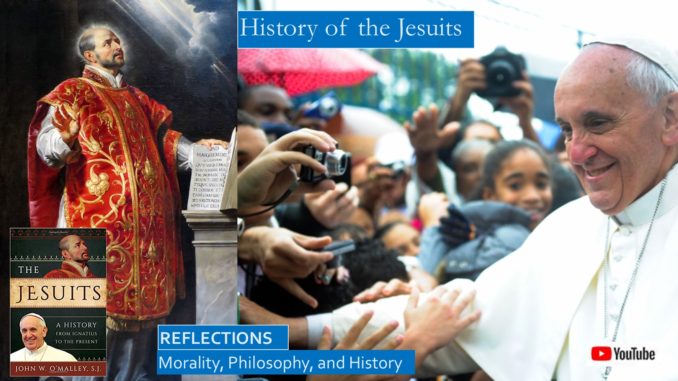
The Jesuits, no religious order has spawned as much passion and controversy as the Jesuits. The book the Jesuits, A History form Ignatius to the Present, has been written by John O’Malley, a Jesuit priest and professor, who has also written outstanding histories of the Council of Trent and Vatican II. O’Malley writes histories that respect the institutions of the Church, but that also take a balanced view of the past so we can learn from it.
What is so fascinating about the Jesuits is how they responded to the modern world, and how they differed from the Dominicans and Franciscans and other medieval monastic orders. Why were they so despised? Why was the Jesuit order suppressed? Why were they persecuted, why were they punished? Were they to blame for their troubles? These are difficult questions to answer, and perhaps our questions and answers will tell us more about ourselves than the Jesuits, but we must try.
The Jesuit order was formed in 1540 shortly before the Council of Trent was convened. The founder, Ignatius Loyola, was a wounded soldier who decided to change careers and serve the Church. He would become the soldier for Christ in the church militant, vigorously advancing the cause of the church, defending the Catholic Church from its enemies.
How was Ignatius Loyola converted? He had served in the military for the small state of Navarre in Spain. During a battle with the French a cannonball shattered his legs, leaving him with a lifelong limp. After several excruciatingly painful medieval operations he recuperated at the castle of Loyola for many months, with two books at his bedside, excerpts from the Golden Legend on the holy lives of Saints, and the Life of Christ by Ludolf of Saxony. He examined his life and prayed and pondered whether he should be a limping soldier, or lead a life like St Dominic and St Francis. Gradually he became convicted that God was calling him to a new life.
When Ignatius had recovered sufficiently he set out on pilgrimage to Jerusalem, but was waylaid at a town near Barcelona, partially because of an outbreak of the plague. While living in a cave he absorbed himself so deeply in a regimen of long hours of prayer and fasting and self-flagellation the he fell into despair, even contemplating suicide. Eventually he shook off his despair and relaxed his religious regimen.
Ignatius enrolled in the University of Paris, where one of his roommates was Francisco Xavier, who would become the famous Jesuit missionary to India and Asia. After graduation ten classmates in all, including Loyola, traveled about Italy and Rome, where their order, the Brotherhood of Jesus, was approved by Pope Paul III.
The Jesuits shares with the medieval orders the vows of poverty, chastity, and obedience, but in addition the Jesuits take a fourth vow. O’Malley emphasizes this fourth vow is not a vow of loyalty to the pope, as many think it, but rather the fourth vow is a vow to go on “mission anywhere in the world, to be ready to travel among the Turks, or to the New World, or to the Lutherans, or to any others whether infidels or faithful.” They looked to the pope to send them out on mission, or to the superior general of the Jesuit order. The Jesuits also differed from the older religious orders in that they did not wear a distinctive habit, they did not give up their family name, and they were not be required to meet for group prayer several times a day.
The Jesuits started a modern ministry, the RETREAT, based on Loyola’s major work, the Spiritual Exercises. Weekend retreats today are common, Jesuit retreats can be longer, and are times of self-reflection similar to Loyola’s time of self-reflection when he asked for God’s guidance. Many in the sixteenth century criticized these retreats for under emphasizing the sacramental and penitential life and over emphasizing the direct communication of the individual believer with God, which many felt was a false mysticism. Indeed, Loyola’s Constitutions, the rule for Jesuits, does not prescribe penances or austerities for the brothers.
In addition to their wide ranging missionary ventures, the Jesuits were also deeply involved in the establishment of schools and colleges. The Council of Trent focused on the need to better education and catechize the faithful and the clergy. The Jesuits had the highest educational requirements for their brothers.
Schools were frightfully expensive, even when the Jesuits were the teachers, especially since the order did not want to charge tuition so even the poorest could attend their schools. Consequently, the Jesuits were forced to become experts in fund raising. O’Malley does not mention this, but probably the Jesuits fell victim to the same tendency in today’s non-profit organizations dependent on fund raising, where the top executives need a large salary to fund a lifestyle sufficient to circulate among the wealthy who needed to fund their schools. The myth grew that all Jesuit orders printed money in their basements. So their generosity to the students of the poor indirectly stoked the envy of others. (Chapter 1, pp 1-26)
The Jesuits marched to wherever the Catholic Church and the pope needed them to march. This was the era of the church militant, and the Jesuits were in the thick of the battle, and their enthusiasm likely led to more misjudgments. O’Malley does not adequately describe how violently polarized the Protestants and Catholics were at the time. A well-known Protestant book of this era is Foxe’s Book of Martyrs, it contains one early church example of martyrdom, the other stories are about Protestant martyred by Catholics. One of the more memorable stories is how some Anabaptists were tied to a pier in the ocean at low tide, slowly drowning as the tide came in. The accuracy of these stories are intensely debated, but all of the stories cannot be totally false, and regardless of degree of truthfulness of the stories, the fact that such a book would be so popular is testament how violently vitriolic these times were.
Competition between the Jesuits and the more established orders like the Franciscans and Dominicans could be just as intense as between Catholics and Protestants. In the eighteenth century there were intense squabbles between the Jesuits and Jansenists. Jansenists were strict Augustinians who believed that free will had little or no power in the sinner’s struggle against original sin. The Jesuits were less extreme, quoting from O’Malley, “Jesuits and others who ascribed to probalism taught that, in a conflict of opinion among respect theologians over the morality or immorality of a given act, the confessor was obliged to give the penitent the benefit of the less rigorous option, even if that opinion was regarded as less probable.” Also, the Jesuits respected the pagan Greek and Roman classics, as part of their educational endeavors, whom abhorred the Jansenists; and the Jesuits favored more frequent reception of the Eucharist, which Jansenists felt cheapened the sacraments. To the Jansenists, “the Jesuits were compromisers who betrayed the purity of the Gospel message and preached an easy road to salvation.” Some Jansenists became obsessed with destroying the Jesuits. (Pp 68-73)
The Jesuits were accused of arrogance, some saw their very name, the Brotherhood of Jesus, of symbolizing arrogance. The Jesuits were confessors to much of the royalty of Europe. Their perceived wealth, their ties to the Pope, real or imagined, their identification with the monarch, their popular preaching, their excellent education, all these factors only increased the envy of many. One unfortunate lesson of the Protestant Reformation was that if a prince or king converted to Protestant, he could easily increase his wealth by seizing church properties. In medieval Europe the pope and princes were constantly battling over who would control investitures of church officials, in this contest the pope had moral authority, while the monarchs had temporal authority in their large armies. Like slow moving dominos, the Jesuits were banned in one kingdom at a time, their properties seized, until the pope was forced in 1773 to formally abolish the Jesuits. The Jesuits would survive in Russia and Poland under the protection of Catherine the Great, and under the radar in America. (75-87)
The French Revolution and the Napoleonic Wars devastated the Catholic Church, all church properties and lands in France were auctioned off. Two successive popes were imprisoned in France. In the aftermath of Congress of Vienna in 1814 restored the monarchies to their thrones in Europe, including the pope, and soon thereafter the order of the Jesuits was resurrected. There was institutional memory of the Jesuit order, but very few Jesuits from before the bans were still alive, so the order had to start from scratch. Most everywhere they were before the Jesuits tried to re-establish their schools, seminaries, printing presses, and churches, but in places like France they were banished three more times in the anti-clerical climate of the times. (89-93)
O’Malley also tells the story of the Jesuit missionary activities in Latin America, Africa, and Asia in particular. In Paraguay around 1700 the Jesuits were able to organize the Indians into large settlements called reductions, even obtaining royal permission for the natives to bear arms to battle marauders seeking to enslave them. But this permission was soon revoked and the natives were disarmed, and eventually the reductions were dissolved entirely. (73-75)
Also around 1700 the Japanese and Chinese missions had some successes, and some martyrdoms, depending partly on who was emperor. The Chinese emperor was friendly to the Jesuits, who devised a Chinese rite for the Mass, but two popes forbade the Chinese rites and also the adaptation of elements of Confucianism into the local church, which was the beginning of the end of the Jesuit missionary venture in China.(64-68) Permitting local rites and customs would be part of the Vatican II reforms many centuries later.
Since they were so heavily involved in higher education and in publication of theological journals, the Jesuits were deeply involved in the intellectual Catholic ferment of the late nineteenth and early twentieth century that would lead to the reforms of Vatican II. Many of Loyola’s spiritual works gained greater circulation. A Congregation of Jesuit leaders issued a decree encouraging ecumenism with other religious traditions. A Jesuit Refugee Service was established as a Jesuit ministry.
There was some tension with Pope John Paul II, who grew up under communism, and the Latin American Jesuits, who because of their struggle for their poorer parishioners sympathized with liberation theology, which attempts to synthesize Marxist and Catholic thought. Their support for the poor did not endear them to the ruling regimes, and during the civil war in El Salvador the army martyred six Jesuits, including a Jesuit university president. Pope John Paul II came to be a major supporter of the Jesuit order. The Jesuits mirror the Catholic Church in its membership, three quarters of Jesuit recruits now come from outside Europe and North America, a truly global order.
What can we say about the Jesuits? They are a modern religious order seeking its way in an often hostile modern world. Their glories and their failings mirror the spiritual lives of all modern believers in an unbelieving modern world. The Jesuits believe in rigorous education, to life the church out of ignorance, trying to strike a balance between reason and faith, scientific inquiry and tradition, the temporal and the eternal. We in the west do not live in a world where we hear church bells ring to remind us to pray multiple times a day, so we must always make an effort to fit God in our lives. We must strike a balance between humility and zeal, all too often we must discern when it is time to turn the other cheek and when it is time to overturn the tables of the money changers.
The pondering of the history of the Jesuits brings to my mind the only talk I remember from the Promise Keeper weekends I attended many years ago. This pastor was giving a talk on the spiritual malaise pastors often suffer after laboring in the ministry after a dozen years. He said that he was given a name of an older preacher who often helped those ministers stuck in the doldrums catch the wind of the Holy Spirit in their sails again. This older preacher asked him if there were any trysts or romantic entanglements, as there was little he could do in those situations. He was assured that this was not the case, and so he was invited to fly in and spend a few days with him in prayer and fellowship.
He was told that often a successful minister will in the beginning have some early years of success, the ministry is exciting, the many souls he wins for the Lord brings deep satisfaction and a true sense of accomplishment. He asked him how his prayer life was, how much time he spent in contemplation and study with the Lord, for its own sake, not so much to prepare for the next Sunday’s sermon. For the Lord never cares so much for your accomplishments, for it is through the grace of God were able to accomplish anything, indeed we cannot even breathe if it were not for the breath of God breathed into our lungs, we cannot live without our heart beating every second. How fleeting are life and its accomplishments! But God cares deeply on whether we Love Him, whether we spend time in prayer and pondering on His Word, whether our walk with the Lord is the central path in our short lives here on Earth.[1]
[1] John O’Malley, “The Jesuits, A History from Ignatius to the Present,” (New York: Sheed and Ward, 2014).

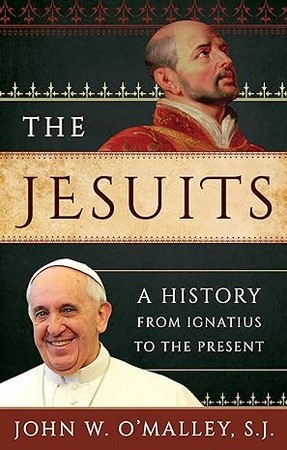
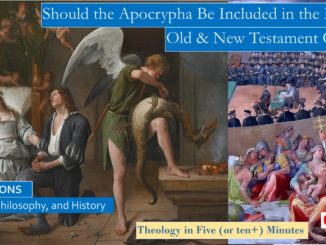
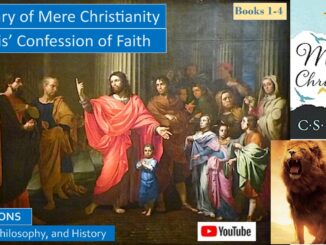
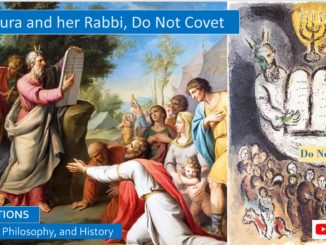
2 Trackbacks / Pingbacks